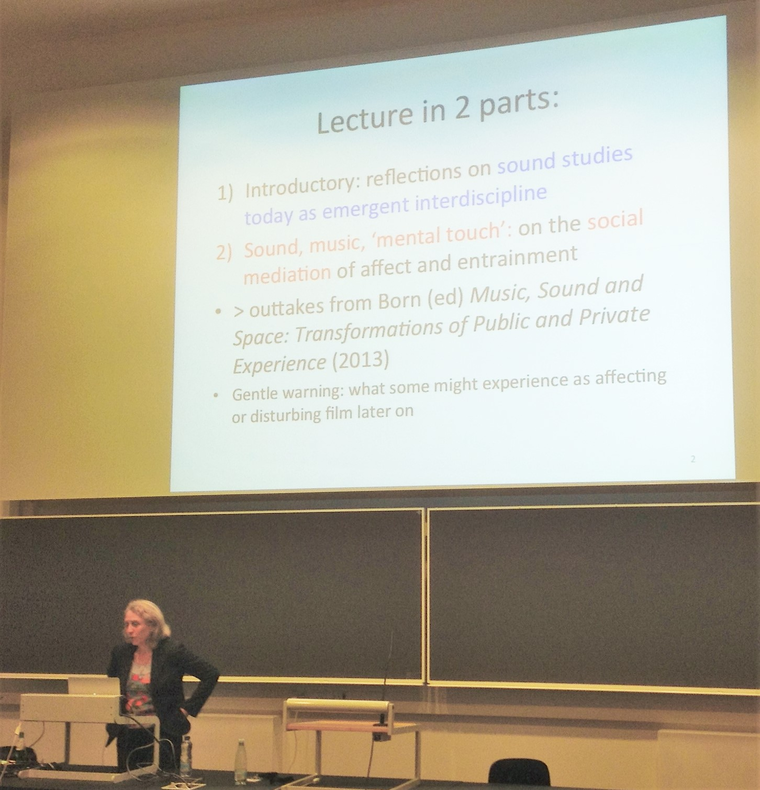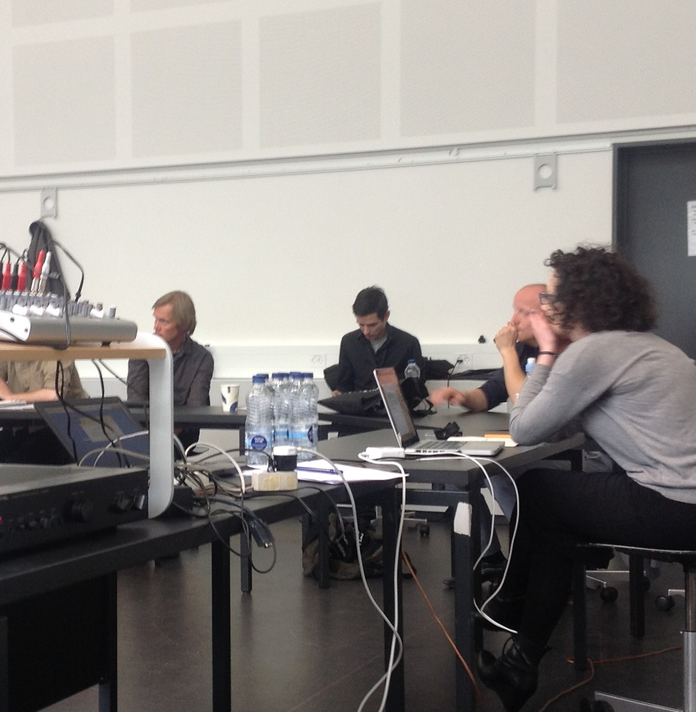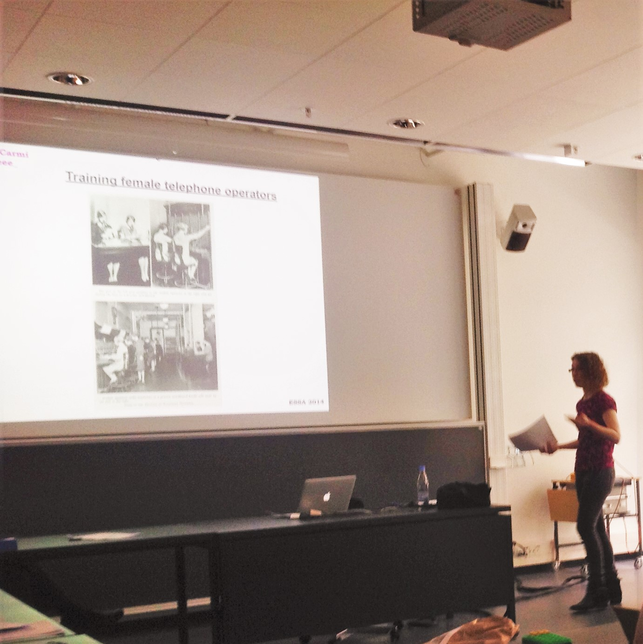On June 27–29, 2014 the second international conference of ESSA, the European Sound Studies Association, took place at the University of Copenhagen, Denmark, organized in cooperation with Norsound, the North-European network for sound studies.(1) The main theme was “mapping the field.” The organizers witnessed a growing interest, both in- and outside academia, for (research into) sound artworks, sound archives, sound designs, audio books, for methodologies of sound studies, for sonic histories, for studying various listening attitudes, for audio technologies, etc. Therefore, a mapping seemed appropriate, albeit one that would never be complete and transparent, in other words, a mapping with many loose ends and interferences …
Ann Lislegaard – Oracles, Owls ... Some Animals Never Sleep
Excerpt taken from https://www.youtube.com/watch?v=dRXZhctzmdc (posted by Biennale de Lyon on 13 September 2013)
Sound art, visual art, and new technologies come together in “Oracles, Owls … Some Animals Never Sleep,” a work by Norwegian artist Ann Lislegaard, one of the keynote speakers at ESSA 2. “Oracles, Owls … Some Animals Never Sleep” is a video of a digitally animated owl projected twice on adjoining screens. The owls deliver monologues of aphorisms and latent fragments from the I-Ching that are interrupted by compressed noise and dramatized and distorted samples from Blade Runner. The owl thus emerges as a rather unstable oracle, with its constantly ruptured and disintegrating linguistic structures.
As the organizers stated, emerging from various traditional disciplines within the humanities and social sciences (musicology, art history, media and cultural studies, psychology, architecture, urban planning, and many more), sound studies has become an inter- or transdisciplinary field. Or perhaps it is better to speak of fields, plural …
Norie Neumark – Mapping Soundfields: A User’s Manual
Excerpt taken from her keynote speech on 28 June 2014
In her keynote speech, Norie Neumark, a sound theorist and media artist from Australia, presented a series of soundmap-making exercises, from the making of cartes de tendre (charting emotions) to sketching psychogeographic maps (deploying tactics) and designing enchanted maps (wondering at possibilities). In this short fragment, Neumark’s speech interacts with Yoko Ono’s Cough Piece from 1961.
(1) For the proceedings of the first ESSA conference, see the Journal of Sonic Studies 7.
The conference’s aim was to test, nurture, challenge, refresh, and transform the epistemological, theoretical, methodological, and historical premises defining the fields of sound studies as well as to develop ideas as to what the future of sound studies can or should be.
Potential questions: what kind of theoretical apparatus is needed to analyze and contextualize the interrelations between one’s being in a sonic environment and disciplinary, artistic, political, and societal changes? What kind of methodological approaches do sound studies call for? What can the role of historical research and (new) technologies in current and future sound studies be? How do we listen, how have we been listening, and how will we be listening to sounds and silences? These and many other questions were addressed in keynotes (by Georgina Born, Norie Neumark, Ann Lislegaard, and Carolyn Birdsall), performances, installations, and over 75 paper presentations …
Georgina Born, Professor of Music and Anthropology at Oxford University, addressed the differences as well as similarities between music studies and sound studies and how the one can (positively) affect the other, thereby recommending a real inter- or transdisciplinarity.
In their round table discussion, Daniela Cascella, Holger Schulze, Marcel Cobussen and (the specter of) Salomé Voegelin investigated the methodologies and heuristics of sound studies: sound does not only have to be an object of study but can also become a “tool” through which research can take place.
In and through their performance, Marta Zapparoli and Martin Kuentz explored the (im)possibilities of pre-digital hardware, thereby challenging the (institutional) borders between music and sound art. By employing hacked CD-players, hissing microphone capsules, damaged magnetic tape, and mutilated cassette players, they created their own musique concrète.
Taking Bell Laboratories as her case study, Elinor Carmi concentrated on the bio-political role of sound and noise: how are people’s bodies and their environments shaped, constructed, controlled, and governed by specific ideas about noise and (unwanted) sounds.
Out of all the presentations, the JSS editors have selected eight contributions which, taken together, should not only give an overview of the versatility of the conference, but also of sound studies in general.(2) Hence, the tenth issue of the Journal of Sonic Studies contains
- An essay by Anahid Kassabian on the role of sound in the immersive experience of “timekiller games,” a subset of casual games that are mostly played on smartphones, iPads, and browsers;
- A discussion about the affordances and potential pitfalls of data sonification seen both as an aesthetic and a knowledge-producing practice. Thomas Bjørnsten reflects on recent notions concerning data sonification within sound-based experimental and artistic practices;
- A critical reflection by Nicola Gess on the relation between music/sound and a reactionary “ideology of presence,” a lost essence sought and rediscovered in music/sound. As an alternative, Gess proposes an understanding of music/sound as a symbolic form in historical and sociological contexts, which it can simultaneously take critical positions on;
- A phenomenological study by Martine Huvenne on the role sound and music play in conveying specific experiences to a movie audience. Said differently, how can an audience feel the essence of a filmic plot through sound (music) instead of merely understanding it?
- A study on the relation between historical material properties and sound design as well as between listening traditions and characteristic product sounds. Anna Symanczyk takes the vacuum cleaner as the main example and investigates the role of sound of these devices, through a close analysis of several advertisements;
- The development of a micro-temporal media archaeology paired with object-oriented ontology by Morten Riis. He takes as point of departure a practical artistic engagement with electro-magnetic recording devices, thus studying the way in which these devices collect and store auditory data;
- An artistic and theoretical exploration by Norie Neumark on how voice attaches us, aesthetically and affectively, to each other and to other creatures and things in the world;
- A presentation by Leo Murray of the tripartite sign classification system (icon, index, and symbol) of C.S. Peirce in relation to sound tracks. Murray applies the Peircean model as a means to understand how sounds, in conjunction with images, can be used to create meaning for an audience.
Through text, sounds, images, and videos, the Journal of Sonic Studies presents current topics and goings-on in our contemporary and versatile world of sound studies.
(2) The presenters reworked their papers for the JSS format, so they may sometimes differ significantly from their presentations in Copenhagen.




